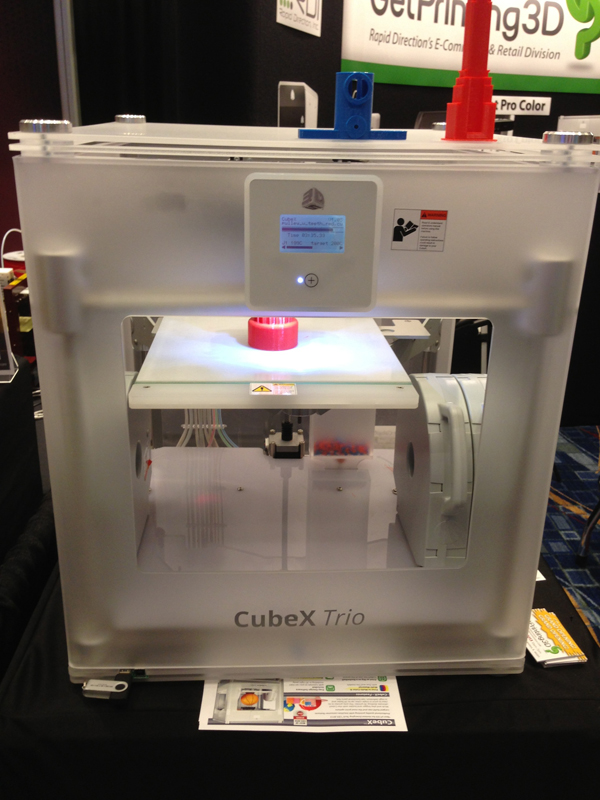3D-Printing Not Yet Mainstream, But Critics Are Missing the Point (Op-Ed)
As 3D printing expands, naysayers question whether the tech is a fad — but those detractors are missing the point, says Scott Dunham.


Scott Dunham is a research manager with Photizo Group, a market research and consulting firm. This article was adapted from Dunham's post to the Photizo Group website. He contributed this article to Tom's Guide's Expert Voices: Op-Ed & Insights.
First, it was the 3D-printing evangelists. They really started coming out of the woodwork around 2010, when 3D Systems bought into the personal 3D-printing market, making claims like "3D printing will be bigger than the Internet," and "3D printing is the next industrial revolution."
Do I dispute those claims directly? Not exactly, but I certainly recognize the nature of those who make such claims. Usually, they come from people who have a vested interest in making 3D printing popular.
Now, the 3D-printing detractors are getting their share of the spotlight — for each action, there is an equal and opposite reaction, I suppose. They're saying things like "3D printing is a gimmick," and "3D printing has no commercial value."
I do have to admit that, in my experience, those in the 3D-printing detractor camp usually have more direct experience with the technology than do the advocates. But I can't help but end up disagreeing with them to a greater degree than I do with the evangelists.
A recent survey from U.K.-based market research firm Ipsos MORI is making its rounds in the 3D blogosphere and Twittersphere under the headline "Only 6 Percent of Britons Want a 3D Printer," and is being accompanied by plenty of skepticism on what this might mean for the future of 3D printing as a widely adopted technology that will change life as we know it.
Here's the thing — whether you're an evangelist or detractor, few people are looking at "consumer" 3D printing with the right perspective. 3D printers aren't meant for everyone. I think content produced using 3D-printers will be more popular commercially than the actual printers themselves.
The elements of trial and error, persistence, and patience — which most people claim need to be eliminated from the desktop 3D-printing experience in order for it to succeed — will never be completely eliminated. You can't create something worthwhile without some degree of dedication, persistence and hardship. The thoughtless operation of the latest tablets and smartphones will not apply here.
What does this mean for widespread 3D-printing adoption? It simply means that most people need to put this fantastic technology into perspective. The study from Ipsos MORI illustrates this concept. Most people appear surprised that "only" 6 percent of the British population said they were interested in owning a 3D printer. Some assumed that, like the smartphone, 3D printers would, at this point, have nearly universal appeal among consumers. Others, seeing the 6 percent data point, would use this as validation to prove that 3D printers aren't legitimate and could never live up to the claims being made about them.
But let's think about this a little bit: 6 percent of the U.K.'s population is nearly 4 million people. The number of personal 3D printers that have been sold so far is likely fewer than 50,000 units worldwide. That's a staggering difference in potential future demand, in just one country.
Now, I'm not saying that survey really proves anything — there's still no telling if all those people who say they want a 3D printer will actually get one. But the point is this: At a consumer level, 3D printing is probably going to stay in the realm of hobbyist and semiprofessional usage by people who want to invest the time and effort to become proficient with the technology, in whatever form that may be. It is when these future hobbyists start applying 3D printing to their other hobbies and businesses that the technology will really start to take off.
The content that will be 3D printed in the future probably will be more popular than 3D printers themselves, in terms of consumer adoption. That content alone is going to be pretty revolutionary. But if the study out of Britain demonstrates anything, it's that there's still a huge pool of future demand for 3D printers. They might not be in every household, but if you're expecting them to be, you're probably looking at the technology the wrong way.
The views expressed are those of the author, contributed to the Tom's Guide's Expert Voices: Op-Ed & Insights section, and do not necessarily reflect the views of the publisher. This version of the article was originally published on Tom's Guide.
Sign up to get the BEST of Tom's Guide direct to your inbox.
Get instant access to breaking news, the hottest reviews, great deals and helpful tips.
Tom's Guide upgrades your life by helping you decide what products to buy, finding the best deals and showing you how to get the most out of them and solving problems as they arise. Tom's Guide is here to help you accomplish your goals, find great products without the hassle, get the best deals, discover things others don’t want you to know and save time when problems arise. Visit the About Tom's Guide page for more information and to find out how we test products.
-
CrArC "The number of personal 3D printers that have been sold so far is likely fewer than 50,000 units worldwide."Reply
"likely" fewer? Where has this number come from? 50,000 is alarmingly low, if it's true. -
The_Trutherizer Well one thing is for sure.. Its not going away. We have only scratched the surface of the technology's potential applications. The printers themselves are more or less still at the level of old school dot matrix to make a rough analogy.Reply -
joneb Unless the future is so bleak we can't innovate like we did in the last century where computers went from filling a room to barely filling the palm of a hand, few people having large heavy video players to tiny units that can be carried in small bag. From big massive printers whose inks were costly to cheap units that can be thrown away and the inks are justa few pounds then I woul guarantee 3D printing will eventually be consumer level, gesture and speech control will be the future until the human brain can manipulate wirelessly. You people really need to get your head out the sand and look at history for a vision of the future.Reply -
Gulli I think expectations should be moderate: yes, millions of people will buy 3D-printers in the future and no, this own't make factories obsolete, after all, factories can always buy bigger 3D-printers and use them more efficiently than you can at home.Reply -
DRosencraft I think the thing most skeptics have a problem with seeing is how a 3D printer helps with anything but shipping cost. Yes, you can 3D print something like a gun, but how many gun buyers want to go through the pain of manufacturing their own gun? You can get almost anything next day shipping if you want. 3D printing will gain traction at some point, but it's got a steep embedded paradigm to overcome. Fans of 3D printing will have to be patient.Reply -
eacrowley Great insights Scott! Balanced and objective. Clearly, 3D is going to have an impact - the ONLY question in my mind is how much and how fast?Reply -
Gomer_Pyle 3D printing has been around for a long time, aka rapid prototyping. The problems are size limitations, materials, resolution, and speed. Yes, speed. They are very slow to make parts as the polymer needs to be cured. You cannot make very large objects (usually limited to about a cubic foot), and the materials are not the greatest - strength and finish. The surface finish is not very good, even with high resolution printing.Reply
But they are good for the original intent: prototyping. Mass production, not so much. Actually, not at all. In the future, maybe, but that's a long way off. We use the latest and greatest Stratasys equipment and it has a long way to go. -
pepe2907 What is clear to me is that this is more of a manufacturing tech as it is a consumer one, and it's for those who like to manufacture something and are willing to educate themselves how to do that. In the same time it will shift the definition of manufacturing quite a bit and will most likely make it more wide and likely will make more people willing to participate in manufacturing of physical objects /and that is not a small thing/.Reply

